Approaching Improvisation in Classical Guitar, Leo Brouwer's 'Paisaje Cubano Con Tristeza' - Estratégias de estudo para a obra Paisaje Cubano Con Tristeza, de Leo Brouwer
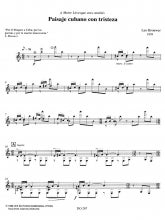
Paisaje Cubano Con Tristeza, de Leo Brouwer, faz parte de uma série de obras de título Paisaje Cubano. A série compreende seis peças, sendo três delas escritas para violão solo (Paisaje Cubano Con Campanas, Paisaje Cubano Con Tristeza e Paisaje Cubano Con Fiesta). Em Paisaje Cubano Con Tristeza está presente o elemento da improvisação, a ser executada na forma de cadenza furiosa, entre os compassos 49 e 50. Será apresentada a seguir uma proposta de estudo da peça, utilizando ferramentas normalmente aplicadas em obras escritas, no intuito de trabalhar o improviso desde os estágios iniciais do estudo, de forma integrada com o restante da obra. As ferramentas escolhidas para para desenvolver os exercícios são: note grouping, de James Morgan Thurmond, sistema numérico de Marcel Tabuteau e a proposta de criação de gráficos, de John Rink.
O estudo da improvisação é algo incomum na formação do violonista clássico. Este fator deixa o violonista despreparado ao lidar com peças como a de Brouwer, ou ainda numerosas obras de instrumentação livre que utilizam a improvisação como elemento principal. O termo “cadenza” está relacionado, por tradição, ao virtuosismo. As cadenzas, muitas vezes escritas pelos compositores, são momentos de alto nível técnico, geralmente com passagens melódicas rápidas e de ritmo livre, que exigirá muito preparo do performer. Para isso, segue abaixo uma possibilidade de estudo da improvisação em conjunto com o estudo da obra, utilizando as mesmas ferramentas. Desta maneira, o violonista que nunca estudou anteriormente a improvisação poderá fazê-lo com elementos presentes na obra e em seu estudo diário.
Note grouping
O note grouping, de James Morgan Thurmond, é um sistema de estudo da performance focado no fraseado de linhas melódicas. No caso de Paisaje Cubano con Tristeza, o note grouping pode auxiliar tanto no estudo dos motivos que formam a peça (figuras 1 e 2), que se apresentam por vezes sobrepostos (figura 3), quanto nas frases melódicas (figura 4) e no estudo da improvisação (este será tratado no tópico 1.4).
A aplicação da ferramenta consiste em fazer agrupamentos de notas, sendo que eles devem começar nos tempos fracos e terminar nos tempos fortes dos compassos, pensando no direcionamento da frase de arsis para tesis (tempo fraco para tempo forte), evitando acentuações indesejadas em tempos fortes e dando direcionamento às frases. Pequenos grupos são formados e, posteriormente, esses grupos são unidos, formando grupos maiores, que também devem ser unidos até formarem uma frase (figura 4).
 | 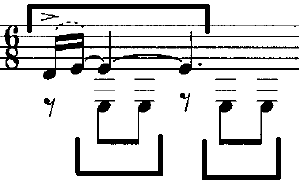 | ||
| Figura 1: compasso 1 | Figura 2: compasso 10 |
Os grupos formados correspondem às células no qual a obra irá se desenvolver e irão ser utilizados no estudo da improvisação.

Figura 3: compasso 4

Figura 4: compasso 23 e 24
Na figura 4, os grupos representados pelas letras f, g, h e i serão unidos, formando os grupos maiores j e k, que representam as frases musicais. É possível, ainda, unir os grupos j e k, formando uma frase maior. Cada passo do estudo deverá ser feito evitando acentuações exageradas nos grupos.
Os números de Tabuteau
O sistema numérico de Marcel Tabuteau é uma forma de estudar elementos musicais através do uso de números, que servem como medida para a execução de exercícios. Estes números podem tanto auxiliar na definição de parâmetros para diferentes tipos de sonoridades, como para medir aspectos como dinâmica e andamento. Em trechos com grande variação de elementos, utilizar uma unidade de medida para criar exercícios que sigam uma ordem progressiva, visando alcançar o domínio de cada aspecto presente na obra a ser trabalhado, tais como velocidade e dinâmica. Um exemplo é utilizar números para cada mudança de velocidade (v1, v2, v3...), como mostra a figura 5.

Figura 5: compassos 21 e 22
As mudanças de andamento (figuras 6 e 7) também podem ser estudadas através do uso de números como medida de variação, para que o intérprete tenha uma noção da diferença de cada novo tempo em relação ao anterior e mais domínio das variantes na execução.
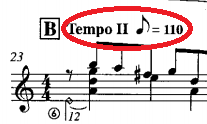 | 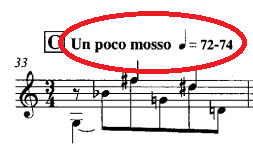 | ||
| Figura 6: compaso 23 | Figura 7: compasso 33 |
Gráficos de Rink
John Rink sugere a criação de gráficos para observar aspectos específicos da obra musical, como sua dinâmica e andamento, o que é chamado por ele de “análise para intérpretes”. Embora seja possível observar mudanças de andamento ou dinâmica na partitura, criar um gráfico específico de cada aspecto torna possível observar em uma única imagem, como essas mudanças se dão ao longo da obra, assim como as partes que tem mais mudanças em geral. Observando as variações de cada aspecto a ser trabalhado, é possível fazer um planejamento de estudos que acompanhe cada um deles e suas variações no decorrer da obra.
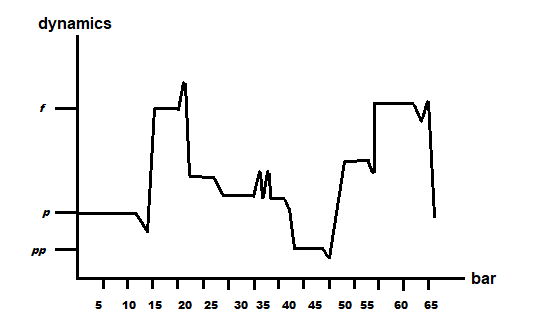
Figura 8: gráfico de dinâmica
Estudando a improvisação
A proposta é que o intérprete crie pequenos exercícios e organize-os em medidas progressivas. A criação dos exercícios se dará nas seguintes etapas: primeiramente, será feita a seleção de pequenos trechos de diferentes partes da obra, escolhidos dos pequenos grupos do note grouping (ver figuras 1, 2 e 3). Depois de selecionados os grupos, organizá-los de maneira progressiva, observando os gráficos feitos (figura 8) e seguindo a variação de material que a peça apresenta. Em seguida, utilizar o sistema numérico de Tabuteau para criar medidas de execução dos exercícios, assim como v1, v2, v3, para velocidade, ou i1, i2, i3, etc., para intensidade. Uma vez que os exercícios com pequenos grupos forem estudados, formar frases musicais com estes grupos e tocá-las. Posteriormente, criar novas frases musicais, retirando alguns dos grupos dados e acrescentando notas improvisadas. Retirar progressivamente trechos e improvisando novos até criar frases totalmente improvisadas. Estudar as frases em velocidade progressiva.
A escolha de criar os exercícios para a improvisação com o material e as ferramentas utilizadas foi feita com o intuito de que o performer possa não só criar uma improvisação que esteja relacionada estruturalmente com a obra, mas também com a própria fase de estudo e preparação, para criar conexões entre o material sonoro escrito pelo autor e o criado pelo performer, desde as primeiras etapas de estudo da obra.

Figura 9: exemplo de montagem
Referências
ANNALA, H.; MÄTLIK. H. Handbook of Guitar and Lute Composers. Pacific: Mel Bay Publications, 2007.
JACOBS, A. A New Dictionary of Music. Harmonsdworth: Penguin Books, 1967.
MACGILL, David. Sound in Motion. Bloomington: Indiana University Press, 2007.
RINK, J. Musical Performance: a guide to understanding. Cambridge: Cambridge University Press, 2002.
THURMOND, James Morgan. 1991. Note Grouping. Lauderdale: Meredith.
Translation (English):
Paisaje Cubano Con Tristeza, by Leo Brouwer, is part of a series of works titled Paisaje Cubano. The series comprises six pieces, three of them written for solo guitar (Paisaje Cubano Con Campanas, Paisaje Cubano Con Tristeza e Paisaje Cubano Con Fiesta). In Paisaje Cubano Con Tristeza, there is the element of improvisation, to be performed in the form of a cadenza furiosa (furious cadenza), between the 49th and 50th bars. This paper examines approaches to improvisation, using tools normally applied in written works, in order to integrate the improvisation with the rest of the piece. The tools chosen to develop the exercises are: note grouping by James Morgan Thurmond, Marcel Tabuteau's numerical system, and John Rink's graphing proposal.
The study of improvisation is something unusual in the formation of the classical guitarist. This factor leaves the guitarist unprepared in dealing with pieces such as Brouwer's, or numerous works of free instrumentation that use improvisation as the main element. The term "cadenza" is traditionally related to virtuosity. The cadenzas, often written by the composers, are moments of high technical level, usually with fast melodic passages and free rhythm, which requires much preparation from the performer. However, it is possible to study the improvisation along with the rest of the piece, using the same tools. In this way, a guitarist who has never previously studied improvisation can do so with elements present in the work and in their daily study.
Note grouping
James Morgan Thurmond's note grouping is a performance study system focused on the phrasing of melodic lines. In the case of Paisaje Cubano con Tristeza, note grouping can help both the study of the motifs that form the piece (Fig. 1 and 2), which sometimes appear superimposed (Fig. 3), as well as in the melodic phrases (Fig. 4) and in the improvisation study (this will be discussed in topic 1.4).
The application of the tool consists of making groups of notes, wherein they should start in the upbeat and end in the downbeat, thinking about the direction of the musical phrase from arsis to thesis (upbeat to downbeat), avoiding undesirable accents on the downbeat and giving a direction to the phrase. Small groups are formed, and later these groups are joined, forming larger groups, which must also be joined together to form a phrase (Fig. 4).
 |  | ||
| Figure 1: Bar 1 | Figure 2: Bar 10 |
The groups formed correspond to the cells in which the work will develop and will be used in the study of improvisation.

Figure 3: Bar 4

Figure 4: Bars 23 and 24
In Figure 4, the groups represented by the letters f, g, h and i will be joined, forming the larger groups j and k, which represent the musical phrases. It is also possible to join groups j and k, forming a larger phrase. Each step of the study should be done avoiding exaggerated accentuations in the groups.
The Tabuteau’s numbers
The numerical system of Marcel Tabuteau is a way of studying musical elements by the use of numbers, which serve as a measure to practice the exercises. These numbers can either assist in setting parameters for different types of sonorities, or to measure aspects such as dynamics and tempo. In sections with large variation of elements, use a unit of measure to create exercises that follow a progressive order, aiming to reach the domain of each aspect present in the work to be studied, such as speed and dynamics. An example is to use numbers for each change of speed (v1, v2, v3 ...), as shown in Figure 5.

Figure 5: Bars 21 and 22
Changes in tempo (Fig. 6 and 7) can also be studied using numbers as a measure of variation, so that the performer could sense the difference with each new tempo in relation to the previous one and have more control of the variants while playing.
 |  | ||
| Figura 6: compaso 23 | Figura 7: compasso 33 |
Rink Graphics
John Rink suggests the creation of graphs to observe specific aspects of the musical work, such as dynamics and tempo, which he calls "analysis for interpreters". Although it's possible to observe changes of tempo or dynamics in the score, creating a specific graphic of each aspect makes it possible to observe in a single image, how these changes occur throughout the work, as well as the parts that have most changes in general. By observing the variations of each aspect to be worked, it's possible to make a planning of studies that accompany each of them and their variations in the course of the work.

Figure 8: Dynamics graphic
Studying improvisation
The proposal is for the interpreter to create small exercises and organize them into progressive measures. The creation of exercises should take place in the following stages: firs, to select small cells of different parts of the work, chosen from the small groups of note grouping (see Fig. 1, 2 and 3). After selecting the groups, to organize them progressively, observing the graphs made (Fig. 8) and following the variation of material that the piece contains. Then use the numerical system of Tabuteau to create measures to play the exercises, such as v1, v2, v3, for speed, or i1, i2, i3, etc., for dynamics. Once the exercises with small groups have been studied, to form musical phrases with these groups and play them. Afterwards, create new musical phrases, removing some of the small groups and adding improvised notes. Gradually withdraw stretches and improvise new ones until you create totally improvised phrases. Study those phrases in progressive speed.
The choice of creating exercises for improvisation with these material and tools was made with the intention that the performer could not only create an improvisation that is structurally related to the work but also to the stage of study and preparation itself, creating connections between the sound material written by the author and the one created by the performer, from the first stages of study of the work.

Figure 9: Example of improvisatory phrases
References:
ANNALA, H.; MÄTLIK. H. Handbook of Guitar and Lute Composers. Pacific: Mel Bay Publications, 2007.
JACOBS, A. A New Dictionary of Music. Harmonsdworth: Penguin Books, 1967.
MACGILL, David. Sound in Motion. Bloomington: Indiana University Press, 2007.
RINK, J. Musical Performance: a guide to understanding. Cambridge: Cambridge University Press, 2002.
THURMOND, James Morgan. 1991. Note Grouping. Lauderdale: Meredith.





